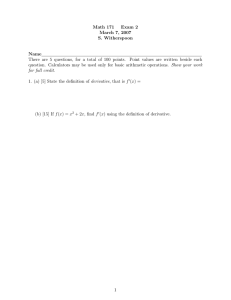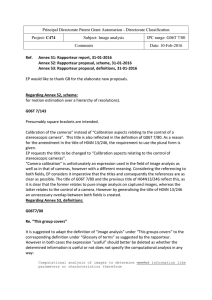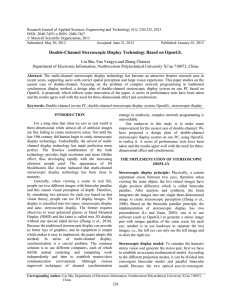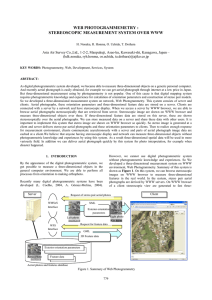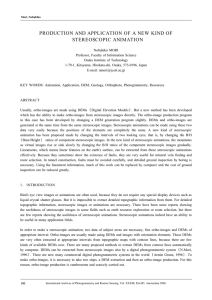A 3D-PTV T P
advertisement
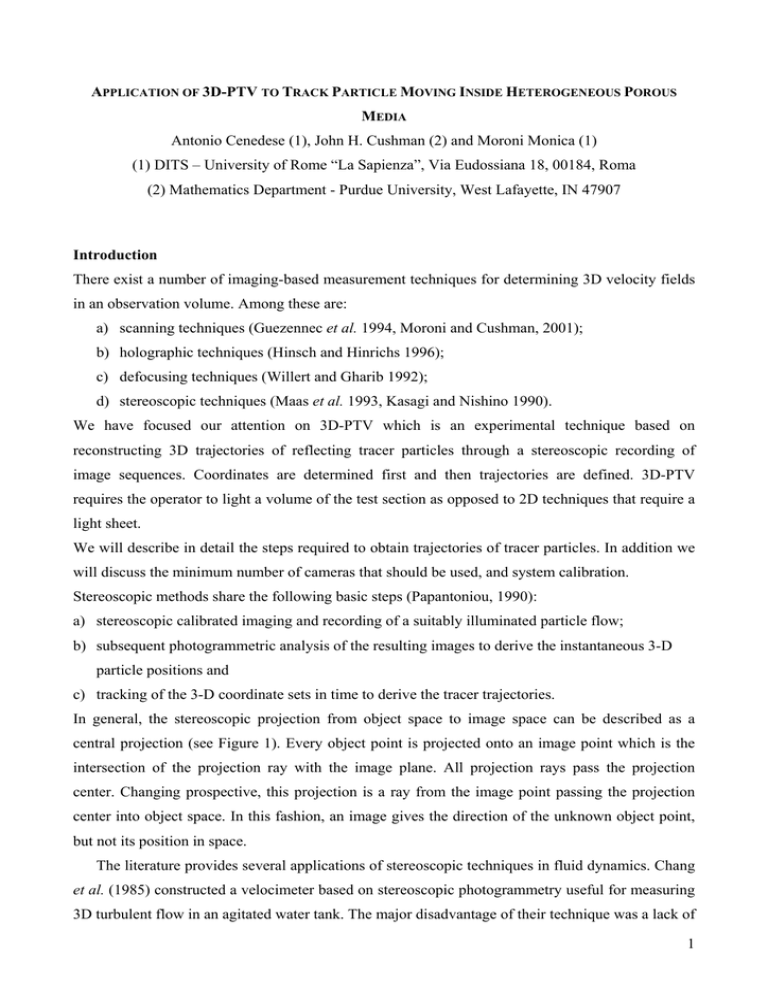
APPLICATION OF 3D-PTV TO TRACK PARTICLE MOVING INSIDE HETEROGENEOUS POROUS MEDIA Antonio Cenedese (1), John H. Cushman (2) and Moroni Monica (1) (1) DITS – University of Rome “La Sapienza”, Via Eudossiana 18, 00184, Roma (2) Mathematics Department - Purdue University, West Lafayette, IN 47907 Introduction There exist a number of imaging-based measurement techniques for determining 3D velocity fields in an observation volume. Among these are: a) scanning techniques (Guezennec et al. 1994, Moroni and Cushman, 2001); b) holographic techniques (Hinsch and Hinrichs 1996); c) defocusing techniques (Willert and Gharib 1992); d) stereoscopic techniques (Maas et al. 1993, Kasagi and Nishino 1990). We have focused our attention on 3D-PTV which is an experimental technique based on reconstructing 3D trajectories of reflecting tracer particles through a stereoscopic recording of image sequences. Coordinates are determined first and then trajectories are defined. 3D-PTV requires the operator to light a volume of the test section as opposed to 2D techniques that require a light sheet. We will describe in detail the steps required to obtain trajectories of tracer particles. In addition we will discuss the minimum number of cameras that should be used, and system calibration. Stereoscopic methods share the following basic steps (Papantoniou, 1990): a) stereoscopic calibrated imaging and recording of a suitably illuminated particle flow; b) subsequent photogrammetric analysis of the resulting images to derive the instantaneous 3-D particle positions and c) tracking of the 3-D coordinate sets in time to derive the tracer trajectories. In general, the stereoscopic projection from object space to image space can be described as a central projection (see Figure 1). Every object point is projected onto an image point which is the intersection of the projection ray with the image plane. All projection rays pass the projection center. Changing prospective, this projection is a ray from the image point passing the projection center into object space. In this fashion, an image gives the direction of the unknown object point, but not its position in space. The literature provides several applications of stereoscopic techniques in fluid dynamics. Chang et al. (1985) constructed a velocimeter based on stereoscopic photogrammetry useful for measuring 3D turbulent flow in an agitated water tank. The major disadvantage of their technique was a lack of 1 accuracy in the direction of the depth of lighted volume caused by the small viewing angles in the stereoscopic photogrammetry. Dupont et al. (1999) present an optical set-up designed and manufactured to investigate the motion of aerosol particles under microgravity conditions. The optical scheme of the set-up is based on a unique objective that collects the light coming from different directions and transfers it to four different cameras. Stüer et al. (1999) present 3DPTV as in instrument to monitor fluid patterns in experiments on Marangoni convection and flow with fluid columns. Kasagi and Nishino (1990) applied 3D-PTV to turbulent measurements. Maas et al. (1993) used 3D-PTV to measure the velocity field in a 24 m laboratory channel and in stirred aquarium. Viewing the sample volume from two perpendicular directions is advantageous because it simplifies the calculation of 3D particle positions, and it allows one to sample the test volume from diverse directions. Unfortunately the flow geometry sometimes does not allow such a setup to be used. The point is discussed in detail in Becker et al. (1999) where the application of multi-image photogrammetric triangulation for measuring the motion and shape of liquid bodies (bubbles, drops, fluid columns and free liquid surfaces) from several images with different viewpoints is suggested. The ideal setup for obtaining highly accurate trajectories requires the cameras to be mounted with the distance between them equal to the distance to the center of the measurement volume (with three cameras this requires a hexagonal cell!!!). But the camera arrangement is usually a compromise between ideal geometrical conditions for a homogeneous distribution of accuracies in the measuring volume and practical restrictions associated with the experiment. The position of the cameras in object space (exterior orientation) and the parameters of each camera (interior orientation) are needed to reconstruct the 3D objects. These parameters can be calculated simultaneously in a so-called “bundle adjustment” or by pre-calibration. In this regard, the fundamental mathematical theorem of photogrammetry can be used in two different modes: a) Spatial resection and spatial intersection: a. the parameters of the exterior orientation and the camera model are determined through a calibration procedure from images of a reference body; b. after calibration of the system and establishment of multi-view correspondences, 3D particle coordinates can be determined based on the orientation and camera model parameters. b) Bundle adjustment: using multiple images of a scene from each camera taken under different orientations, object point coordinates, camera orientation parameters and camera model parameters can be determined simultaneously based only on image space information in object space to retrieve the magnification factor (Becker et al., 1999). 2 Z Z z’ • O (X0’, Y0’, Z0’) y’ F ’ •( x0, y0) •Pi (xi’,yi’) Z0’ Y’ x’ Pi Y X0’ Y X’ 0 X Figure 1 . Collinearity condition with camera model inverted for drawing purposes Experimental set-up to detect 3D-PTV lagrangian trajectories A matched index (of refraction) porous medium heterogeneous at the bench scale has been constructed by filling a hexagonal Perspex tank (25×60 cm2 side) with Pyrex beads. In particular, different porous media heterogeneous at the laboratory scale have been constructed with Pyrex cylindrical beads of 0.4, 0.7, 1.0 cm as diameter and 1.9 cm Pyrex spheres. Three different mean flow rates were studied and the respective Reynolds numbers have been computed. Algorithms have been developed to analysis the images and to extract the 3-D trajectories. The calibration procedure should be divided into three steps. The first one determines the calibration parameters in air. The frame with points of known spatial coordinates is placed in air to avoid multimedia environmental problems. Such problems arise during the second and third step. The second step consists in calibrating the system when the frame is placed inside the test section, while during the third the known points are immersed into glycerol. The comparison among the calibration parameters will be useful to test the accuracy of the results. 3 In bundle adjustment calibration, the image coordinates of a test field are measured and the system is rotated and turned to simulate different camera positions. For the adjustment process it is sufficient to know the object coordinates of the test field points only approximately. Following the bundle adjustment process, the exterior orientation parameters are obtained in the coordinate system of the test field, together with the interior orientation parameters of each camera. Next step is to transform the exterior orientation parameters in the test section coordinate system. Because we know the 3D coordinates of the control points in the test section coordinate system, a spatial affinity transformation between the object points of both systems determines the parameters for the transformation into the test section reference system. xi zi 90 52 cm zi Yi 52 cm xi 60° 60° Xi 52 cm 90 yi zi Figure 2. Camera adjustments The three-dimensional trajectories are reconstructed through a stereoscopic technique. The stereoscopic system must be calibrated first and then the “epipolar line” method must be applied to determine the 3D position of the tracer particles imaged by the cameras. Finally, 3D trajectories will be reconstructed through an algorithm for tracking similar to the one use in the 2D case (see Moroni and Cushman, 2001). The time integral scales for two sets of data are presented in Tab. 2 while the velocity correlation functions are presented in figure 3. 4 1/e 3 giri 6 giri Txx (s) 0.8392 1.7791 Tyy(s) 0.6657 1.5873 Tzz(s) 4.3893 2.1154 Heterogenous (higher velocity) 1 Rho_x_6g_I Rho_y_6g_I Rho_z_6g_I 0.8 Rho 0.6 0.4 0.2 0 -0.2 0 2 4 6 8 10 tau (s) Heterogenous (lower velocity) 1.2 1 Rho 0.8 Rho_xx_3g_D Rho_yy_3g_D Rho_zz_3g_D 0.6 0.4 0.2 0 -0.2 0 2 4 6 8 10 12 14 tau (s) Figure 3. Comparison of velocità correlations along the principal axes for two sets of data References D. Papantoniou and Th. Dracos, 1990, "Lagrangian Statistics in Open Channel Flow by 3-D Particle Tracking Velocimetry", Engineering Turbulence Modelling and Experiments, Rodi and Ganic eds., Elsevier. 5 F. Yamamoto, T. Uemura, M. Iguchi, and M. Koukawa, "A Binary Correlation Method Using a Proximity Function for 2D and 3D PTV", FED - vol. 128, Experimental and Numerical Flow Visualization ASME 1991; S.T. Barnard and M.A. Fischler, 1982, "Computational Stereo", Computing Surveys 14(4), 553 572; H.G. Maas, 1992, "Complexity analysis for the establishment of image correspondences of dense spatial target fields", International Archives of Photogrammetry and Remote Sensing, XXIX, B5, 102-107; Becker J., W. Bosemann and R. Bopp, 1999, “Photogrammetric methods applied to fluid motion within a fluid matrix”, Meas. Sci. Technol. 10, 914-920. Chang T.P.K., Watson A.T. and Tatterson G.B., 1985, “”, Chem. Eng. Sci. 40, 269-275 N. Kasagi and K. Nishino, 1990, "Probing Turbulence with Three-dimensional Particle Tracking Velocimetry", Engineering Turbulence Modelling and Experiments, Rodi and Ganic eds., Elsevier. Dupont O., Dubois F., Vedernikov A., Legros J.C., Willneff J. and Lockowandt C., 1999, “Photogrammetric set-up for the analysis of particle motion in aerosol under microgravity conditions”, Meas. Sci. Technol. 10, 921-933. Stuer H., Mass H.G., Virant M. and Becker J., 1999, “A volumetric 3D measurement tool for velocity field diagnostic in microgravity experiments”, Meas. Sci. Technol. 10, 904-913. 6
